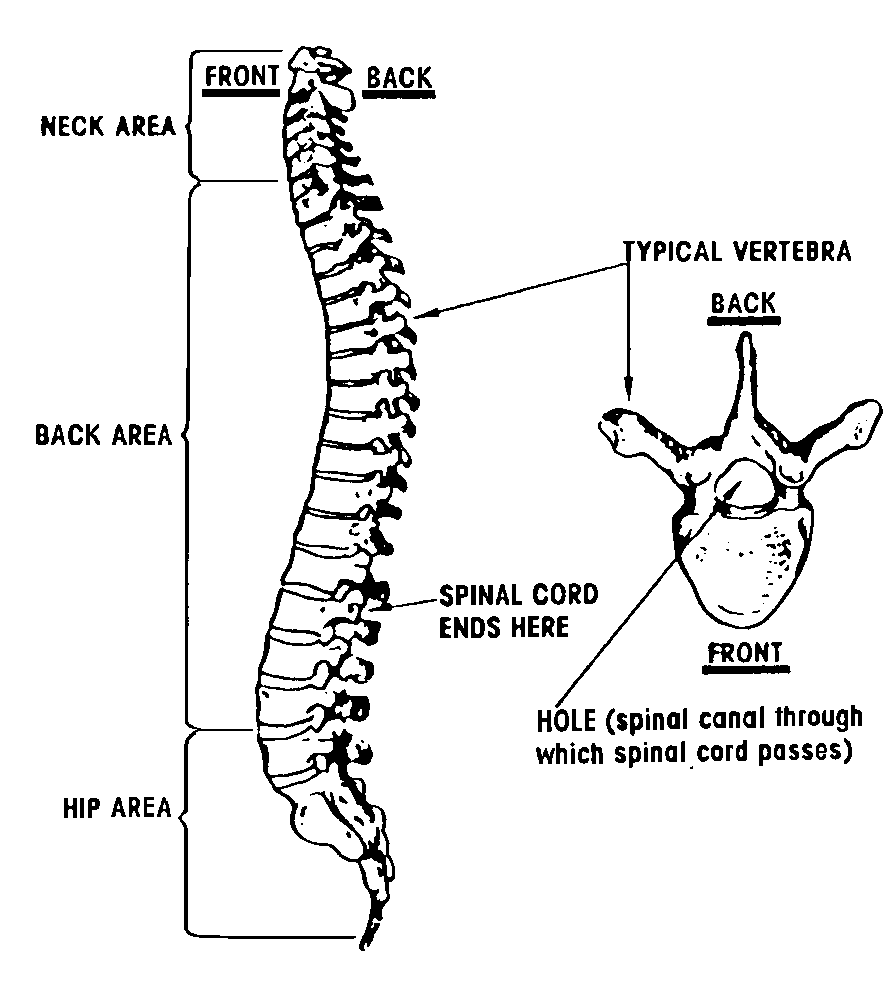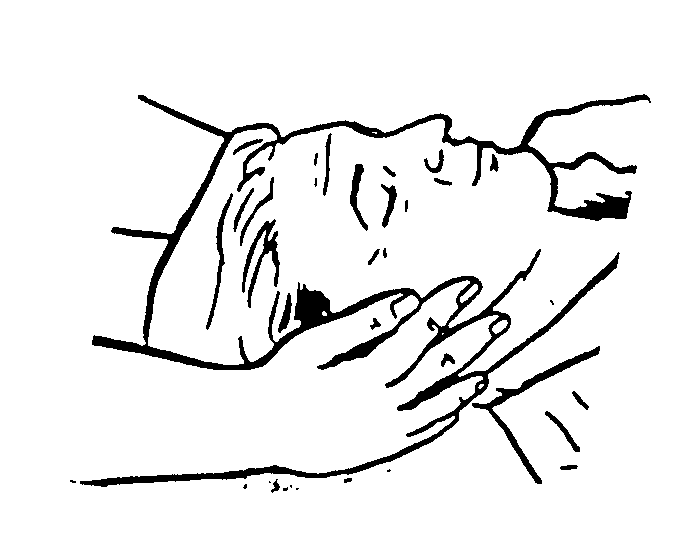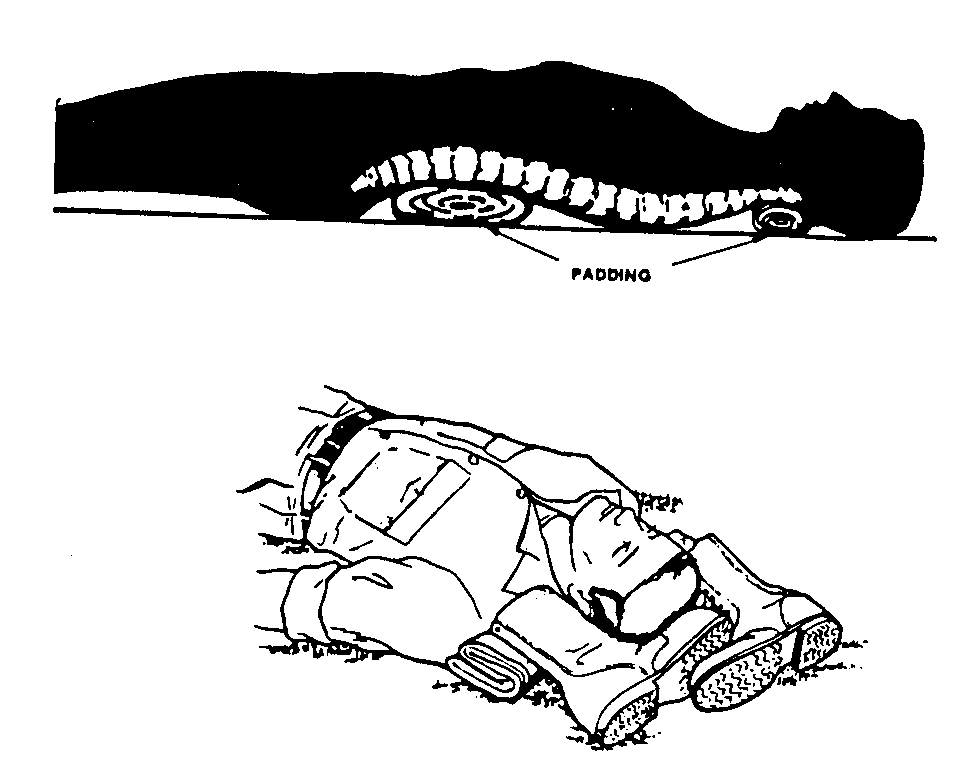
LESSON 10
IMMOBILIZE A SUSPECTED SPINAL INJURY
Identify proper procedures for immobilizing a suspected spinal injury.
CONDITIONS
Given multiple-choice items pertaining to spinal injuries.
STANDARD
Score 70 or more points on the 100-point written examination.
REFERENCES
STP 21-1-SMCT, Soldier's Manual of Common Tasks: Skill Level 1.
FM 21-11, First Aid for Soldiers.
10-1. INTRODUCTION
The spinal column (also called the backbone or spine) consists of a series of bones called vertebrae. The top seven vertebrae are the bones of the neck. The spinal column surrounds and protects the spinal cord. The spinal cord consists of nerves which carry impulses between the brain and the rest of the body. If the spinal cord is severed (cut completely), the muscles and sensations controlled by the portion of the spinal cord below the cut will not function.

FIGURE 10-1. SPINAL COLUMN
10-2. IDENTIFY SIGNS AND SYMPTOMS OF A FRACTURED SPINE
Always check a casualty who is lying down and breathing for spinal injury, especially if the casualty has suffered a fall or has been hit in the back. Signs and symptoms of an injured spine include:
Pain or tenderness of the neck or back.
Cut or bruise on the neck or back.
Inability to move part of the body (paralysis), especially the legs.
Lack of feeling in a body part. (Touch the casualty's arms and legs and ask if he feels your hand.)
Loss of bladder and/or bowel control.
Weak respiration.
Head or back in an unusual position.
10-3. MOVE A CASUALTY WITH A SUSPECTED SPINAL INJURY, IF NECESSARY
WARNING
Do not move a casualty with a suspected fracture of the spine unless it is necessary to move the casualty from an immediate life-threatening danger (fire, etc.) or if the casualty is not breathing and you must position him for mouth-to-mouth resuscitation. Moving the casualty could result in permanent paralysis or even death.
If a life-threatening danger exists, it may be necessary to move the casualty out of danger before providing treatment. If the casualty must be moved prior to treatment, great care must be taken to avoid causing additional injury to the casualty. A minimum of four soldiers must be used to move the casualty. Procedures for lifting a casualty using the four-man arms carry (a four-man variation of the two-man arms carry discussed in Lesson 14) are given below.
The first soldier (the leader who is the most experienced person available lifesaver) kneels at the casualty's head facing the casualty's feet, places his hands on each side of the casualty's head and jaw, and pulls back slightly to manually immobilize the head and neck.
 FIGURE
10-2. MANUALLY IMMOBILIZING THE CASUALTY'S HEAD AND NECK
FIGURE
10-2. MANUALLY IMMOBILIZING THE CASUALTY'S HEAD AND NECK
The other three soldiers kneel at the casualty's side and place their hands and forearms under the casualty's shoulders, waist, hips, thighs, knees, and ankles.
On the command, "Lift," from the leader, all soldiers rise to their knees in unison, keeping the casualty's head and spine in straight alignment.
If a long spine board is available or one can be improvised from a door or board, the casualty should be placed on the spine board. The spine board will help to immobilize the casualty's spine during evacuation. The following steps are used to place the casualty on a spine board.
When the leader gives the command, "Lift," a fifth soldier slides the spine board into position under the casualty.
On the command, "Lower," from the leader, the soldiers bend in unison and gently lower the casualty onto the spine board while keeping the head and spine in alignment.
The soldiers then secure the casualty to the spine board, carefully lift the spine board, and move the casualty to safety. The leader should keep manual traction on the casualty's head while the other four soldiers carry the spine board and casualty.
When a safe location is reached, the soldiers gently lower the spine board and casualty onto a flat surface and fully immobilize the casualty as described in paragraph 10-4.
If a spine board is not available and there is no time to improvise one, the casualty is moved using the four-man arms carry. Steps for moving a casualty after the casualty has been lifted are given below.
On the leader's command, "Turn," the soldiers gently turn the casualty toward their chests as the leader gently turns the casualty's head to maintain spinal alignment.
On the leader's command, "Rise," the soldiers stand in unison, maintaining alignment of the head and spine.
The casualty is then carried out of danger.
When a safe location is reached, the soldiers gently lower the casualty onto a flat surface by reversing the lifting procedures and fully immobilize the casualty as described in paragraph 10-4.
10-4. IMMOBILIZE THE CASUALTY'S SPINE
If the casualty has signs and symptoms of a fractured spine, immobilize the casualty's back, neck, and head.
Treat any casualty that you think may have a spinal injury as though you were certain he had a fractured spine.
Treat any casualty with a severe head injury as though he also has a fractured neck.
WARNING
Do not attempt to straighten the casualty's head or back if it is in an abnormal position.
Tell the casualty to keep still. Any movement could cause additional injury.
Send someone to get medical help.
If the casualty is lying on his stomach, keep him from moving until medical help arrives.
If the casualty is lying on his back, use padding to help immobilize his back, neck, and head as described below.
Roll or fold padding (such as a blanket) until it conforms to the shape of the arch of his back. Then carefully slide the padding under the arch of his back. This padding will help support and immobilize his back.
Slide a roll of cloth under the casualty's neck to help support and immobilize his neck.
Place padded rocks, small padded logs, or filled boots on each side of the casualty's head to keep it from moving. The procedure for using filled boots is described below.
Remove the casualty's boots.
WARNING
Do not remove the casualty's boots if you are in a chemical environment.
Fill the boots almost to the top with sand or small rocks.
Place material (strip of clothing, sock, etc.) on top of the sand or rocks to keep the sand or rocks from falling out.
Tie the top of the boots to keep the material from coming out.
Place the boots around the casualty's head so the head will not turn.
 .
.
FIGURE 10-3. IMMOBILIZING A CASUALTY'S SPINE (PADDING UNDER BACK AND NECK, HEAD IMMOBILIZED WITH BOOTS)